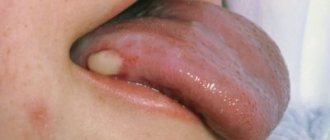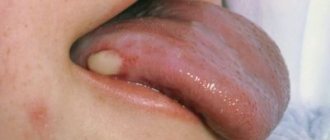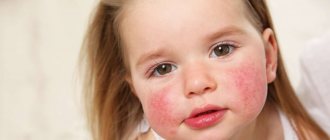General information
The name of the disease is due to the fact that outwardly it looks like a nettle burn - the skin turns pink and swells, while small blisters can merge into large local spots (angioedema) of irregular shape.
Papules cause itching and discomfort; when scratched, the wound surface can become infected, and then dermatitis and other complications join the underlying disease. The disease is very common; every third person on the planet has suffered from urticaria in one form or another.
Symptoms of urticaria in children
The main sign of urticaria in a child is a rash. Its prevalence and severity may vary, but in most cases the disease follows a single pattern.
- Convex pink and red rashes appear that turn pale when the skin is pressed or stretched. When the blisters merge, the edges of the spots become more intensely colored.
- The appearance of blisters, their disappearance or merging into vast shapeless foci occurs chaotically, and their migration over the surface of the body is unpredictable.
- The rash is accompanied by severe itching.
- The temperature may rise, either slightly or to high values.
- Often - weakness, malaise, joint pain and headache.
- In the complicated form, difficulty breathing or swallowing, nausea and vomiting, and bowel movements.
- An even more severe manifestation is angioedema on the lips, oral mucosa, eyelids, cheeks or genitals.
The localization of the appearance of the rash can be anywhere, including on the mucous membranes - lips, nasopharynx, ears and genitals. Most often, the upper part of the body and arms are affected, while the symmetry of the rashes is not always present; the spots take on the most bizarre coral-like shapes.
In most cases, allergies in the form of urticaria in children are accompanied only by the appearance of an itchy rash, which does not last long, from several hours to several days. Often other pathologies give similar symptoms; in this case, urticaria is not considered as an independent disease.
Information for parents! If a rash in the form of hives is accompanied by even slight swelling in the child, especially in the face and neck, you must immediately call emergency help!
When to call a doctor
You should urgently consult a doctor if the rash spreads throughout the body or gets worse, or if signs of infection have already appeared, such as suppuration, bleeding, weeping.
In addition, the rash is not only allergic - it often accompanies dangerous diseases: chickenpox, measles, scarlet fever, rubella, meningococcal meningitis, viral hepatitis. Only a doctor can find out what is the cause of the skin reaction. Therefore, in case of high fever, cough, loss of appetite or constant crying, you should urgently show the baby to a specialist.
If the skin rash is accompanied by wheezing, swelling of the lips or tongue, or difficulty breathing, call an ambulance immediately: this could be an anaphylactic reaction , which can have very serious consequences.
Sources: allergotop.com, medicalnewstoday.com, nationaleczema.org
Causes of urticaria in children
There can be many reasons for the appearance of hives in a child. In addition, it can be caused by different factors in the same person at different ages. Among the most common pathogens in children, the following groups can be distinguished:
- Food products (citrus fruits, nuts, eggs, seafood, strawberries, tomatoes, etc.).
- Food additives, primarily sulfides, salicylates and various chemical dyes.
- Household allergens (dust, fluff, cigarette smoke, pollen, cosmetics and detergents, synthetic clothing, fumes from furniture varnishes, paints, etc.).
- Medicines and contrast agents for radiography.
- Blood (donated) and drugs created on its basis.
- Vaccinations.
- Insect bites, helminthic infestations.
- Physical, including thermal phenomena (overheating and sweating, cold, physical activity, direct sunlight).
- Psychogenic factors.
- Various infections.
All of these factors can become both the cause of primary urticaria and the impetus for its exacerbation during the chronic course of the disease. In children under two years of age, the vast majority of cases of urticaria are caused by food allergens.
How can you tell if your child has severe urticaria or not?
To assess the signs of the disease, a special method has been developed, which is called the “7-day urticaria activity index”. It is very simple and you can easily master it.
Two signs of hives—blisters and itching—should be assessed for seven days. Give each symptom a daily score from 0 to 3 depending on how severe it is.
The total score for 1 day for both traits will be from 0 to 6. To get the total score for 7 days, add all the daily numbers together. The result will show how severe the child's urticaria is:
The results obtained will allow you to evaluate how effective the treatment is.
Authors: Huggies experts, dermatologist Polina Vasilyeva
The mechanism of occurrence of urticaria (pathogenesis)
The human body contains mast cells or mast cells, which are specific elements of connective tissue. They are the central element in the development of urticaria, activators of inflammation. When an allergen enters the body for the first time and in small doses, the child does not experience any external manifestations or reactions, but sensitization occurs, which can be represented as the first acquaintance with the allergen, resulting in the production of histamine. It is this substance that causes redness, swelling and other inflammatory factors. It gradually accumulates in mast cells, and when its amount reaches a critical threshold, the cell membrane is destroyed with the release of histamine into the bloodstream and a subsequent cascade of pathological changes in the body.
Classification of urticaria in children
According to the nature of the course, acute and chronic forms are distinguished.
In the first case, the disease manifests itself abruptly; the symptoms of urticaria continue to bother the child from several hours (usually 6-12) to 1-2 weeks. The rash is accompanied by severe itching, the surface of the skin at the site of the rash becomes hot to the touch. If the outbreak is caused by an allergen, then when contact with it is eliminated, the symptoms disappear quickly and without a trace. With an exacerbation of chronic urticaria, the itching and rashes are less intense, but in this case they can persist for a long period - several weeks and sometimes months. The condition is accompanied by weakness, nausea, loss of appetite, headaches, and, less commonly, stool disorders. Sometimes, against the background of sluggish urticaria, neurotic disorders develop, and since the child constantly scratches the itchy papules, a secondary infection occurs and dermatitis develops.
Based on the severity of the disease, the following types of urticaria in children are distinguished.
- Mild form - external manifestations are almost invisible, the child feels well, there is no itching or intoxication of the body. A minor rash goes away within a day at most.
- Moderate - characteristic rashes are clearly visible, accompanied by fever and itching; intoxication of the body in the form of nausea and headache may be present. The papules merge, swelling appears, and there is a risk of the first signs of Quincke's edema appearing.
- Severe - pronounced symptoms. Severely itchy rash, general intoxication of the body with a gastrointestinal reaction, development of Quincke's edema. Requires urgent medical attention.
Depending on the provoking factor, the child may experience the following types of urticaria:
- Contact - has an allergic origin, in 1st place among the causes are pharmacological and biological factors. When contact with them is eliminated, it goes away without a trace.
- Idiopathic - occurs for unknown reasons. It does not respond well to standard treatment and retains symptoms for a long time.
- Vibration - occurs against a background of strong mechanical vibrations.
- Dermatographic - provoked by mechanical irritation of the skin (tight or synthetic clothing, skin folds, etc.). After eliminating the irritant, it goes away very quickly, usually within half an hour.
- Cholinergic - caused by high physical activity, characterized by the appearance of small rashes.
- Thermal - provoked by uncomfortable (high or low) ambient temperature. Accompanied by particularly severe itching and is the most common cause of edema.
- Aquagenic - a reaction to contact with water. The rash is usually small or absent, but is accompanied by severe itching.
Dermatitis due to food allergies
- Symptoms
An allergic reaction to various foods can be accompanied by the development of edema, the appearance of rashes on the skin in the form of blisters, red spots, rashes in the form of pustules and papules with serous contents, often itching. These symptoms usually occur within minutes to hours after eating the allergen. In addition to skin damage, nausea, diarrhea, and manifestations of hypersensitivity reactions from the respiratory tract are possible. In very young children, food allergies are sometimes accompanied by diaper rash in the folds of the limbs, eczema, and increased dryness or, on the contrary, moisture of the skin.
- Treatment
To treat skin breakouts, you must first follow an elimination diet. In this case, the product that presumably causes a specific reaction is excluded from the diet (in children in the first year of life, most often cow’s milk protein). Local anti-inflammatory therapy using creams and ointments is used as needed. Modern antihistamines are also often recommended to relieve symptoms. Additionally, sedatives can be used (as prescribed by a doctor).
If a child has a food allergy, the doctor may recommend that the child and mother follow a diet (reduce or eliminate milk and dairy products from the diet) if she is breastfeeding.
Formula-fed children need medicinal formulas based on highly hydrolyzed (broken-down) proteins, which do not cause allergies and help normalize the function of the gastrointestinal tract. For example, Nutrilak Peptide MCT , which also contains such important components as omega-3 and omega-6 fatty acids, nucleotides and a balanced vitamin and mineral complex, is recommended for allergies to cow's milk protein and food allergies.
Children are also bottle-fed, but to prevent allergies or for mild manifestations of allergies (taking into account the causally significant allergen and in agreement with the doctor), there are special hypoallergenic mixtures, for example Nutrilak Hypoallergenic . This mixture contains lactobacilli L.Rhamnosus LGG ® - a probiotic with proven effectiveness in the prevention and treatment of atopic dermatitis and eczema in infants. Nutrilak Hypoallergenic contains hydrolyzed protein, as well as bifidobacteria BB-12, which enhance the effect of the probiotic and help improve the balance of microflora.
First aid for urticaria in a child
The primary task is to identify and eliminate the provoking factor. The main problem during this period is not rashes, but itchy skin. When providing first aid, it is important to eliminate it if possible - gently trim the nails, put on protective gloves for infants, apply an available non-hormonal anti-allergic cream (for sunburn, mosquito bites, etc.) to the site of the rash. If there is no cream, you can use a cool compress.
All this is done before medical assistance, which should be provided immediately. In case of development of edema and severe symptoms, it is necessary to call an emergency team.
Treatment of urticaria in children
The choice of treatment tactics for urticaria in children depends on its cause, main symptoms, the age of the child, as well as the stage at which the disease is caught.
Only a doctor can prescribe complete therapy after an accurate diagnosis. The main goals include eliminating precipitating factors, prescribing medications to eliminate symptoms, and treating associated pathologies. The doctor makes the choice of antihistamines and other drugs based on the individual clinical picture. Modern medicine offers new generation drugs that minimize the risk of side effects, have a high level of safety and are easy to use for young children. In severe cases, hospitalization may be required.
Is it possible to bathe a child with hives?
If the disease is not aquagenic in nature, you can and should bathe your child, but it is important to follow the recommendations:
- do not heat the water above +37C;
- do not use washcloths and hygiene products with dyes and fragrances;
- maximum bathing time - 10 minutes;
- the use of herbal decoctions and potassium permanganate should be agreed with a doctor;
- Do not rub the inflamed skin with a towel.
Idiopathic urticaria
To treat this type of urticaria, the child must follow a hypoallergenic diet according to A.D. Ado. The same medications are recommended as for the treatment of exacerbations of moderate urticaria. In case of torpidity, the child may be prescribed long-acting glucocorticosteroids for a course of 2-3 weeks to symptomatic therapy.
Detoxification therapy involves the administration of hemodez 400 mg and the intake of sorbents. The child is prescribed digestive enzymes, for example, mezim or festal, but not in all cases. Based on the identified pathology, the child is prescribed symptomatic treatment: antifungal, antibacterial, etc.
If treatment with antihistamines is effective, then a course of histaglobulin follows.
Possible complications and their consequences
Urticaria, despite its apparent harmlessness, can lead to serious consequences, primarily to Quincke's edema. Its characteristic initial symptoms, in addition to the swelling itself, are difficulty breathing and paroxysmal cough with whistling (bronchospasms). Swelling of the internal mucous membranes is dangerous due to disruption of the housing and communal services, the first signs of which are a gag reflex and stool disturbance. From the nervous system, severe cases of urticaria are dangerous due to damage to the meninges, which can be fatal in the absence of medical assistance.
Treatment of urticaria in children
It is impossible to predict the body's reaction to a particular allergen, however, every parent can protect their child as much as possible from contact with the most active well-known allergens, do not bundle up or overcool, and do not use cosmetics and detergents with dyes and strong fragrances.
If possible, prevent the presence of children in rooms with a strong smell of paints and varnishes, avoid stress, infections and excessive physical exertion. It is recommended to examine the child’s endocrine system and not ignore signs of weak immunity. Unfortunately, urticaria is often not taken seriously; however, it is a disease that, if unfavorable, can threaten the life of a child.
SM-Doctor pediatricians are always ready to help your child; their experience and attentive attitude to each little patient are the key to a quick and correct diagnosis and well-chosen treatment tactics.
Treatment
Not all skin reactions in babies require treatment. Sometimes the rash goes away on its own within a few hours without disturbing the child. But if the symptoms cause obvious discomfort, you should consult a doctor.
In addition to the prescribed treatment, the doctor’s advice will most likely boil down to the following.
- Avoid factors that provoke skin reactions, that is, do not use gels and shampoos, as well as scented creams and lotions, which can irritate children’s skin, to wash and care for the child. Baby's clothes should be washed with hypoallergenic detergents.
- Change your baby's bed at least once a week to reduce contact with house dust mites, and vacuum his room regularly.
- Wash your baby with fragrance-free products, preferably mild hypoallergenic soap. After the bath, you need to wipe the baby dry, but do not rub his skin with a rough terry towel, but blot him with a soft cloth so as not to irritate the skin.
- Use skin moisturizers. A hypoallergenic moisturizer will help prevent dry skin and protect it from irritants.
- Wear gloves for your child, especially while sleeping, to prevent him from scratching his itchy skin. Infections can get into wounds and scratches and cause even more severe irritation.







